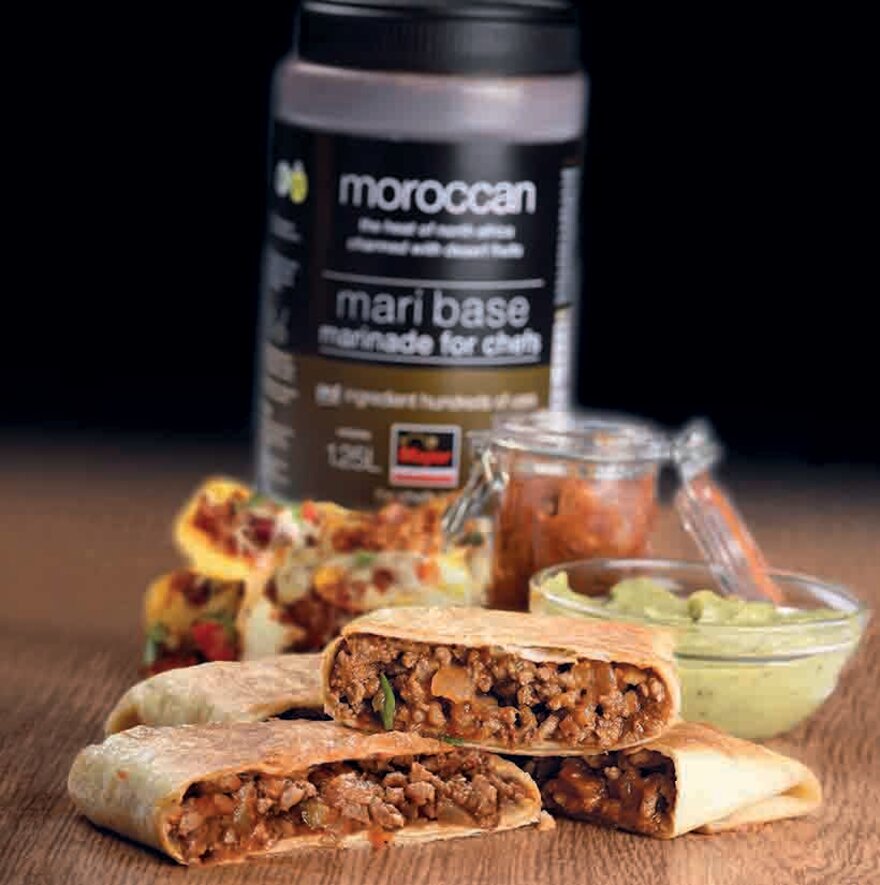Discover a melting pot of new sauces
Finding a base that works for all dietary needs can help streamline your sauce selection. Anne Bruce takes stock of the most efficient
Inclusivity is the chef's number one priority for sauces and stocks in 2023, and that doesn't just mean bringing a plate together. The more special dietary requirement boxes a stock or sauce can tick, from vegan to gluten-free or nut-free to low salt, the better.
Kitchens are under huge pressure at the moment due to factors including staff shortages and rising costs on ingredients and energy and labour, so efficiency is the only way ahead. But in the meantime, health is also a priority and diners expect their special dietary requests to be accommodated if they are allergic to an ingredient or if they are following a special diet such as a vegan. Why should they have to compromise on those occasions that they decide to treat themselves and eat out during a cost of living crisis?
So, while it may mean rethinking recipes, one-size-fits-all convenience and cost-effective solutions that will keep a spectrum of diners happy are what every kitchen is crying out for. At the same time, no-one is forgetting that a sauce or stock has a vital role to play in elevating the plate, adding value to it and making it a higher margin meal, so it must not look like corners have been cut. So, this is an area where suppliers are hard at work to come up with new solutions that keep everyone happy.
Minus the meat
Plant-based has to be pulled out as the key "ask" in sauces, suppliers identify, and the pressure is on to make sure taste is not impacted as conventional recipes are tweaked.
Supplier Macphie says it is responding to the rise of plant-based products, especially those that are almost identical to non-plant-based counterparts. It offers a variety of plant-based options, sweet dessert toppings and bespoke creations, all of which are seeing growth, says Kirsty Matthews, insights and marketing manager.
A key aim for a plant-based sauce is to ensure they are multi-purpose and can be used for both meat and meat-free dishes, allowing chefs and restaurants to cut down on the number of ingredients they need to order in.
"Across the stocks and sauces market there is a clear need for quick-fix sauces that provide that same high quality and flavour profile while easing time pressures for chefs," Matthews comments.
New ingredients are being pulled into service and experimented with to replace animal-based versions, says Jason Trotman, head of culinary operations at Eurest. Nutritional yeast is one of the key ingredients used in place of meat or cheese in Eurest's sauces due to its versatility and salty, savoury flavour. This can be used to make a dairy-free pasta sauce, for example, by blending it with roasted sweet potatoes and rice milk. Alternatively, mixing the yeast with vegetable stock provides a meaty, umami taste.
Aquafaba, the water from tinned chickpeas, is another useful ingredient when catering for special dietary requirements, as it mimics the functional properties of egg whites in sauces such as plant-based mayonnaise.
Get rid of gluten
Gluten and gelatine are often used as thickening agents in commercial sauces and even ingredients like barley malt vinegar are not suitable for a gluten free diet, so it's important to check the label of ready-made sauces, comments Barnaby MacAdam, taste creator at Santa Maria Foodservice.
Using individual portions of pre-prepared stocks and sauces works well for customers with dietary requirements, says Gordon Lauder, managing director of frozen food distributor Central Foods: "Not only are they convenient and simple to use, they also help to cut the risk of contamination, which can have significant consequences," he says.
Central Foods has recently teamed up with sauces and stocks specialist Essential Cuisine to launch a range of individual frozen sauce sachets for the foodservice sector, including peppercorn, Diane and Hollandaise sauces. The individual frozen sachets offer maximum convenience and minimum wastage, Lauder says. All are gluten-free and can be served in a wide variety of ways, such as with meat, vegetables, burgers or open sandwiches, in a move to make kitchen life easier for chefs and other members of staff.
Fergus Martin, development chef at Major International, also makes the case for buying in sauces and stocks. Producing a meat stock from scratch can take many hours to achieve the depth of flavour and rich colour desired. During this time, the chef must keep an eye on the stockpot, ensuring it is skimmed and the correct liquid level is maintained. And the stockpot, being on the stove the whole time, uses energy continuously.
By contrast, quality ready-made stocks and sauces can deliver convenience, consistency and flavour in one, he says. They are quick and easy to produce by any member of the brigade, while storage-friendly packaging means a kitchen can have a range of flavours and formats ready when required.
Take up tech
For an alternative approach to cutting costs on stocks and sauces, the latest developments in bulk cooking technology are helping operators combat the high cost of labour, as well as labour shortages and the cost of energy, as Gareth Newton, managing director, at BGL Rieber outlines.
Large-volume producers such as hospitals or schools can use large self-stirring combination cooking kettles to produce high-quality stocks and sauces. Combination cooking kettles – which feature automated stirring and mixing – are often now used in ‘dark kitchens', where bulk portions are produced for delivery to satellite restaurants.
With cutting wastage a priority in the kitchen, it helps to use every part of an ingredient. Onion skins make a rich soup stock, for example, while coriander and parsley stalks can be saved for fresh Italian-style pestos, Trotman recommends. Once prepared, the stock can be batched and frozen, then used for a variety of purposes. Cook/freeze or cook/chill are also popular options because of their flexibility for storage, delivery and regeneration, Newton says.
Creed Foodservice makes the case for litre-sized table sauce bottles for the casual dining space. It recently developed its own Kitchen ‘72 range of litre-sized bottles of condiment sauces, including garlic mayonnaise and sweet chilli, which are all gluten-free and plant-based. Diners can help themselves, saving staff time, and consequently keeping costs lower at a time when every penny counts, it says.
"Operators should of course be considering details such as this when planning resources – and while it may mean consumers are using that little bit more sauce than they might if it had been served to them at the table, the cost-saving once team time has been factored in to portion, deliver, clear and clean, will be apparent," says Rob Owen, executive development chef at Creed.
Flavour not fat content
Health is also a priority for diners, which should not be ignored when it comes to sauces and dressings, but Trotman has a solution: "With health and wellbeing at the top of the agenda for many of our clients, we find that a generous helping of herbs and spices satisfies the need for flavour without having to resort to an excessive amount of butter, cream and salt."
There's also a growing appetite for food with additional nutrients, according to a Mintel Global Consumer survey into food and drink trends for 2023, which revealed 57% of adults see ‘added nutritional benefits' as the most important factor determining good value, reports Louise Wagstaffe, Premier Foods chef.
One sauce base can also be used by chefs as a blank canvas to add different extra ingredients, signature flavours and spices across different dishes on the menu. For example, a good tomato-based sauce is essential and can be used in a dish, as a topping, or on the side for dipping, MacAdam says.
Salsas with full-bodied tomato flavours alongside onion and jalapeño, can allow diners to customise their meals by requesting mild or hot varieties. There's also the option for chefs to adapt a simple base with store- cupboard spices, such as chipotle or with sour punches of chili and lime, and amp up the indulgence with extras such as grated cheese.
All these small touches will keep diners happy while adding value to the meal, and boosting those all-important margins. Sauces and stocks really could be a magic potion for foodservice operators in credit crunched times.
Suppliers
BGL Rieber www.bglrieber.co.uk
Central Foods www.centralfoods.co.uk
Creed Foodservice www.creedfoodservice.co.uk
Eurest www.eurest.co.uk
Macphie www.macphie.com
Major International www.majorint.com
Premier Foods www.premierfoodservice.co.uk
Santa Maria Foodservice www.santamariaworld.com/uk/foodservice
Continue reading
You need to create an account to read this article. It's free and only requires a few basic details.
Already subscribed? Log In








